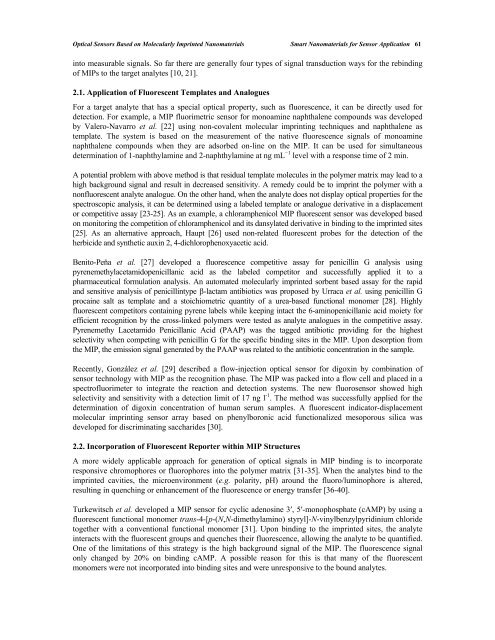Download - Bentham Science
Download - Bentham Science
Download - Bentham Science
You also want an ePaper? Increase the reach of your titles
YUMPU automatically turns print PDFs into web optimized ePapers that Google loves.
Optical Sensors Based on Molecularly Imprinted Nanomaterials Smart Nanomaterials for Sensor Application 61<br />
into measurable signals. So far there are generally four types of signal transduction ways for the rebinding<br />
of MIPs to the target analytes [10, 21].<br />
2.1. Application of Fluorescent Templates and Analogues<br />
For a target analyte that has a special optical property, such as fluorescence, it can be directly used for<br />
detection. For example, a MIP fluorimetric sensor for monoamine naphthalene compounds was developed<br />
by Valero-Navarro et al. [22] using non-covalent molecular imprinting techniques and naphthalene as<br />
template. The system is based on the measurement of the native fluorescence signals of monoamine<br />
naphthalene compounds when they are adsorbed on-line on the MIP. It can be used for simultaneous<br />
determination of 1-naphthylamine and 2-naphthylamine at ng mL −1 level with a response time of 2 min.<br />
A potential problem with above method is that residual template molecules in the polymer matrix may lead to a<br />
high background signal and result in decreased sensitivity. A remedy could be to imprint the polymer with a<br />
nonfluorescent analyte analogue. On the other hand, when the analyte does not display optical properties for the<br />
spectroscopic analysis, it can be determined using a labeled template or analogue derivative in a displacement<br />
or competitive assay [23-25]. As an example, a chloramphenicol MIP fluorescent sensor was developed based<br />
on monitoring the competition of chloramphenicol and its dansylated derivative in binding to the imprinted sites<br />
[25]. As an alternative approach, Haupt [26] used non-related fluorescent probes for the detection of the<br />
herbicide and synthetic auxin 2, 4-dichlorophenoxyacetic acid.<br />
Benito-Peňa et al. [27] developed a fluorescence competitive assay for penicillin G analysis using<br />
pyrenemethylacetamidopenicillanic acid as the labeled competitor and successfully applied it to a<br />
pharmaceutical formulation analysis. An automated molecularly imprinted sorbent based assay for the rapid<br />
and sensitive analysis of penicillintype -lactam antibiotics was proposed by Urraca et al. using penicillin G<br />
procaine salt as template and a stoichiometric quantity of a urea-based functional monomer [28]. Highly<br />
fluorescent competitors containing pyrene labels while keeping intact the 6-aminopenicillanic acid moiety for<br />
efficient recognition by the cross-linked polymers were tested as analyte analogues in the competitive assay.<br />
Pyrenemethy Lacetamido Penicillanic Acid (PAAP) was the tagged antibiotic providing for the highest<br />
selectivity when competing with penicillin G for the specific binding sites in the MIP. Upon desorption from<br />
the MIP, the emission signal generated by the PAAP was related to the antibiotic concentration in the sample.<br />
Recently, González et al. [29] described a flow-injection optical sensor for digoxin by combination of<br />
sensor technology with MIP as the recognition phase. The MIP was packed into a flow cell and placed in a<br />
spectrofluorimeter to integrate the reaction and detection systems. The new fluorosensor showed high<br />
selectivity and sensitivity with a detection limit of 17 ng l -1 . The method was successfully applied for the<br />
determination of digoxin concentration of human serum samples. A fluorescent indicator-displacement<br />
molecular imprinting sensor array based on phenylboronic acid functionalized mesoporous silica was<br />
developed for discriminating saccharides [30].<br />
2.2. Incorporation of Fluorescent Reporter within MIP Structures<br />
A more widely applicable approach for generation of optical signals in MIP binding is to incorporate<br />
responsive chromophores or fluorophores into the polymer matrix [31-35]. When the analytes bind to the<br />
imprinted cavities, the microenvironment (e.g. polarity, pH) around the fluoro/luminophore is altered,<br />
resulting in quenching or enhancement of the fluorescence or energy transfer [36-40].<br />
Turkewitsch et al. developed a MIP sensor for cyclic adenosine 3′, 5′-monophosphate (cAMP) by using a<br />
fluorescent functional monomer trans-4-[p-(N,N-dimethylamino) styryl]-N-vinylbenzylpyridinium chloride<br />
together with a conventional functional monomer [31]. Upon binding to the imprinted sites, the analyte<br />
interacts with the fluorescent groups and quenches their fluorescence, allowing the analyte to be quantified.<br />
One of the limitations of this strategy is the high background signal of the MIP. The fluorescence signal<br />
only changed by 20% on binding cAMP. A possible reason for this is that many of the fluorescent<br />
monomers were not incorporated into binding sites and were unresponsive to the bound analytes.

















